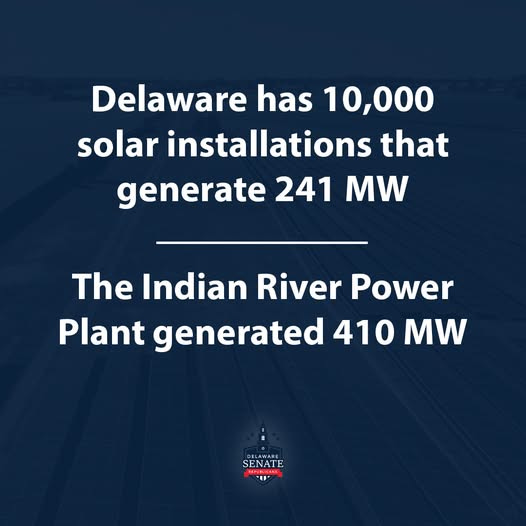
When the Delaware General Assembly gets back to work next Tuesday, they will have a Senate Continuing Resolution to consider from my State Senator, Bryant Richardson. And although it wasn’t my idea, I believe his proposal is worth studying.
This comes just days after the closure that PJM announced back in December of Delaware’s last coal-burning power plant, Indian River Unit 4 (IR4), which indeed was shut down last month. That took a potential 410 MW of power off grid, as Unit 4 was the largest of the four and had been in operation since 1980 - the IR complex itself opened in 1957 with the first unit cranking out 81 MW, the remainder being built out over the next 23 years. While there were rumors of cancer clusters stemming from the plant, those were debunked in a later study. I’m not saying that Indian River was the cleanest place by a longshot, but there are those who oversell the drawbacks as part of an anti-progress agenda.

So I’m going to do some back-of-the-envelope calculations here based on what Community Solar says about the “average” solar installation - which, by the way, has a lifespan of 25 years. (Remember, IR4 was operational for 45 years.)
Community Solar projects can use approximately 5 to 7 acres for every megawatt (MW) of solar installed, so a 4 MW project would require 20 to 28 acres before municipal/county ordinance considerations. As a result, solar developers (“developers”) routinely contact landowners with an option to lease the landowners land to obtain sufficient acreage to develop a project.
If we say five acres for every megawatt, that means over 1,200 acres - almost two square miles, and maybe more - of Delaware land is being used for solar panels, which are surely leaching heavy metals and other pollutants onto the ground they sit on. (Would you want to eat something grown on that land in the first year or two after the solar panels are gone?) To simply match what IR4 provided would take up another square mile of land, and don’t forget: solar panels do no good at night while a coal plant could run 24/7.
Yet what Richardson’s proposal wishes to look at is the possibility of placing what are called Small Modular Reactors, or SMRs, within the state. It presents the exciting possibility of a nuclear plant cranking out 300 MW of reliable power - site two or three around the state and combine them with natural gas plants at places like Indian River and we could eliminate the need for these unreliable, capricious solar and wind farms altogether.
Perhaps I’m more of a fan than most people because I grew up in the vicinity of not one, but two nuclear power facilities: Davis-Besse outside Toledo and Fermi 2 south of Detroit. Both have been in operation for decades, assisting the region with its power generation needs.
The bill itself doesn’t commit the state to anything but a study of the possibility, which by several accounts isn’t quite at commercial viability yet but should get there within the next five years. About the time the earliest solar panels drop offline, we may be able to replace the output with the first of perhaps three SMR plants. And it’s not going to be cheap, either - but then again, ratepayers are paying for other failed projects so at least they’ll get something out of this bargain should it come to pass.
The question, of course, will be whether this proposal gets any support from a Democrat caucus that has the Radical Green lobby so far up its behind that you don’t know where one ends and the other begins. But if they know what’s good for the state, they’ll give the proposal a fair shake and have a legitimate study of the benefits as well as the pitfalls.
And that’s not all the ideas. The other day I restacked a post the Delaware Senate Republicans did with their whole energy program. I encourage you to check it out.
In the meantime, though, you can Buy Me a Coffee, since I have a page there now.




I won't attempt to compare reactor footprint to solar. I have proof that nuclear energy absolutely is elite-funded and probably dangerous. Start here:
https://sustainability.stanford.edu/news/small-modular-reactors-produce-high-levels-nuclear-waste
Then please go read the full article. You won't be sorry.
https://open.substack.com/pub/1longtrain/p/lets-try-this-again?utm_campaign=post&utm_medium=web
Interesting. We'll see if stupidity wins over common sense. In my personal observation, solar panel not only make the land unusable for any other purpose, depending on their height above it, they bake the ground which has to effect it. They are also vulnerable to damage, as in Texas where a THIRTY FIVE HUNDRED acre solar farm got wiped out by a hail storm.